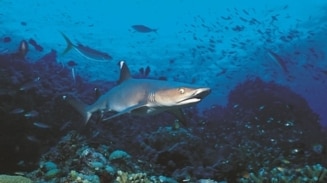The DNA in seawater can reveal the diversity and abundance of fish species living in ocean waters. Christopher Intagliata reports.
海水中的DNA可以向我们展示海洋中鱼类的丰富和多样性。克里斯托弗·因塔利亚塔报道。
The way we sample much of the world’s oceans, to see what’s living down there, is pretty basic: Ask fisherman. Or just stick a net down there, and examine what we catch. Neither method is ideal. “Because you basically catch the fish and kill them.” Philip Francis Thomsen, a biologist at the Natural History Museum of Denmark. Another drawback, he says, is you can’t do it everywhere. “If the bottom is too soft, or too rocky, or there’s a coral reef, you don’t want to use this invasive method above sensitive habitat.”
我们想要知道世界各处的海洋中生活的生物,最基本的便是——向渔民询问。或者撒一张网,然后看看我们抓到了什么。但是这两个方法都并不理想。“因为你只是捕鱼然后杀掉它们。”丹麦自然历史博物馆生物学家菲利普·弗朗西斯·汤姆森说道。另一不足之处是,你不能在每个地方都这么做。“如果海床过于柔软或坚硬,或者海底有一个珊瑚礁,你应该不希望因此给它们造成破坏。“
So Thomsen and his team investigated an alternative, that’s been used in freshwater with some success: they sampled the diversity and abundance of marine life using something called environmental DNA, or “eDNA.” Basically, genetic material that fish leave behind. “So that is all sorts of bodily fluids that are expelled by the fish during its lifetime.” And beyond its lifetime too-like when one fish gets eaten, and its remains get expelled in the fecal matter of another. Bingo: eDNA.
所以汤姆森和他的团队寻找了一个替代的方法,并在淡水环境下使用取得了成功:他们使用环境DNA,即“eDNA“成功对海洋生物取样,揭示了其多样性。eDNA简单来说,就是鱼类留下的含有基因的物质。”那是鱼类在其一生中排出的各种体液。“也可能是一条鱼被吃掉,身体残余作为其他鱼的排泄物被排出。那就是eDNA。
Thomsen and his colleagues sampled seawater at various depths off the southwest coast of Greenland. And then fished out the eDNA in those samples. The researchers were able to identify 26 of the 28 fish families caught in the same area in trawling nets-and at similar abundances, too. They also found a few unique families once they were missed by the nets, and lots of DNA from a species that, in net samples, seemed rare: the Greenland shark.
汤姆森和他的同事们取样了格陵兰西南海岸附近不同深度的海水。然后分析和检测样品海水中的eDNA。研究者们能够确认当地渔民通过拖网捕鱼发现的28种鱼类中的26种,并且有同样丰富的数量。他们也发现一些拖网中没有被发现的独特鱼类,以及用网取样难以发现的格陵兰鲨鱼的大量DNA。

“We found the shark in almost all of the samples. That is because the shark just avoids the trawl. So here’s an example of a species that is actually better surveyed by the environmental DNA than the trawling.” The study is in the journal PLoS ONE. [Philip Francis Thomsen et al., Environmental DNA from Seawater Samples Correlate with Trawl Catches of Subarctic, Deepwater Fishes]
“我们发现格陵兰鲨鱼DNA基本在所有采集的样本中都有出现。这是因为,鲨鱼避开了拖网。因此这说明了有某些生物种类是拖网无法发现的,这是环境DNA测量法的优势。“研究成果发表在《公共科学图书馆:综合》上。
The technique’s not quite ready for primetime in the marine setting at least: for one, ocean currents could transport a species’ DNA far from where the fish may actually be found, and give inaccurate measures. But in the future, it might take the fishing out of fish surveys.
这项技术目前暂不能在海洋中加以应用,其中一点是由于海洋洋流可以把物种DNA运输到离生物实际生活区域很远的地方,造成测量的不精确。但是未来,这项技术可以将鱼类调查从捕鱼的方法中解放出来。
-Christopher Intagliata
请 登录 发表评论